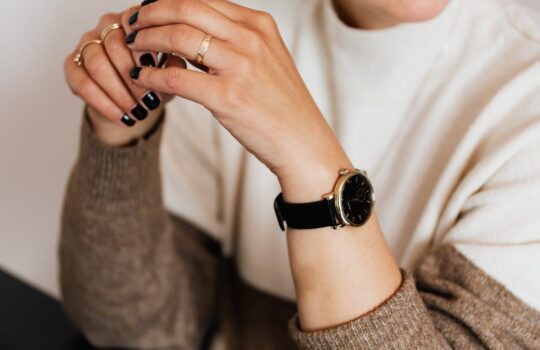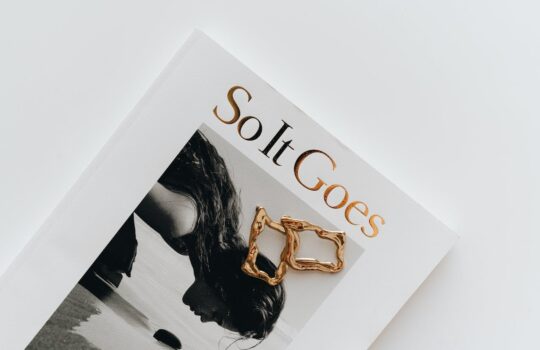PVD Gold Plated vs Gold Filled Jewelry— Which Is Better?

Photo by THAHSINA LENISH via
If you’ve been shopping for jewelry lately, you’ve probably come across the terms gold filled and PVD gold plated. They sound similar, but they’re actually quite different, especially when it comes to durability, appearance, and value.
Let’s break it down simply.
Gold Filled Jewelry
Gold filled jewelry has a thick layer of real gold pressure-bonded onto a base metal. In most cases, the gold makes up about one-twentieth of the item’s total weight. That means it’s much more substantial than regular plating and can last years without tarnishing when cared for properly. Many people who wear their jewelry every day prefer gold filled pieces because they hold up well to moisture, sweat, and daily friction.
Therefore, unlike regular traditional gold plating, the gold in gold-filled jewelry won’t rub off easily because it’s mechanically bonded rather than just coated. This makes it an ideal choice for people with sensitive skin or those who rarely take off their jewelry. With gentle care, gold-filled pieces can last a decade or more, offering an affordable alternative that still feels like real gold.
PVD Gold Plated
PVD, on the other hand, stands for Physical Vapor Deposition. It’s a modern vacuum-coating process that fuses gold particles onto the metal surface. This technique creates a thin yet hard layer that’s more resistant to water, sweat, and fading compared to traditional electroplating. It’s often used in high-quality watches and stainless-steel jewelry because it offers a sleek, long-lasting finish at a lower cost.
While PVD coatings are highly durable, they don’t contain as much real gold as gold-filled jewelry. The coating is thinner, meaning it may eventually wear down in areas that experience frequent friction, like rings or bracelets. However, its superior resistance to tarnish, moisture, and discoloration makes it perfect for everyday pieces, especially those made from stainless steel or titanium.
Gold-Filled vs. PVD Gold-Plated Jewelry
| Feature | Gold-Filled (GF) | PVD Gold-Plated |
|---|---|---|
| Process | A thick layer of real gold (at least 5% of total weight) is mechanically bonded to a base metal (usually brass or copper) using heat and pressure. | A thin layer of gold is vaporized and fused onto a base metal (often stainless steel or titanium) in a vacuum chamber. |
| Gold Content | Contains a measurable quantity of real gold — usually 1/20 (5%) of total weight. | May use real gold or gold-colored alloy, but the layer is microscopic — typically 0.1–0.3 microns thick. |
| Best Base Metals | Brass or copper. | Stainless steel or titanium (highly corrosion-resistant). |
| Appearance | Closely resembles solid gold in color and feel. Often warmer and richer in tone. | Bright and even finish; looks polished and modern, but can appear “coated” to trained eyes. |
| Tarnish Resistance | Excellent — the gold layer itself does not tarnish. | Excellent — PVD bonds tightly and resists discoloration from moisture and oils. |
| Allergy Safety | Generally hypoallergenic, unless base metal is exposed after many years. | Hypoallergenic when applied on stainless steel or titanium; safe for sensitive skin. |
| Maintenance | Minimal — gentle cleaning keeps it shining. | Very low maintenance — waterproof and sweatproof. |
| Repairability | Difficult to repair once worn through (requires skilled jeweler). | Cannot be repaired; must be recoated if worn off. |
| Cost | Higher than PVD because of real gold content. | More affordable and cost-effective for trendy or chunky styles. |
| Everyday Wear | Excellent for constant daily wear — more resistant to friction and long-term exposure. | Great for active wear and humid climates, but may show wear faster on high-friction areas (rings, bracelets). |
| Ideal Use | Everyday fine jewelry with a long lifespan. | Fashion-forward, modern designs meant for versatility — waterproof daily wear, statement pieces. |
Which Is Better?
So, which is better? That depends on how you wear your jewelry. If you’re looking for something you’ll never take off, a ring or bracelet that sees daily wear, then gold filled pieces are generally the better choice. They offer long-term durability and a more “real gold” look. But if you want affordable, trend-driven styles that resist tarnish and still look great after many wears, PVD gold plated jewelry is a smart, modern alternative.
PVD gold plated jewelry is also gaining popularity because it pairs beautifully with stainless steel and titanium. Providing hypoallergenic and waterproof metals. The result is jewelry that’s stylish, durable, and easier to maintain than traditional gold-filled or plated pieces.
| If You Want... | Choose Gold-Filled | Choose PVD Gold-Plated |
|---|---|---|
| High gold content & heirloom quality | √ | |
| Waterproof & sweat-resistant everyday wear | √ | |
| Thicker, long-lasting gold surface | √ | |
| Budget-friendly, trendy pieces | √ | |
| Authentic gold warmth & tone | √ | |
| Low-maintenance, durable coating on stainless steel | √ |
Summary
In short, gold filled jewelry wins for longevity and authenticity, while PVD gold plating shines in affordability, design flexibility, and resistance to daily wear. Both have their place — it just depends on the lifestyle you lead and how you love to wear your gold.




